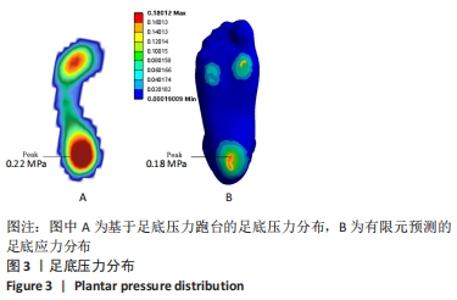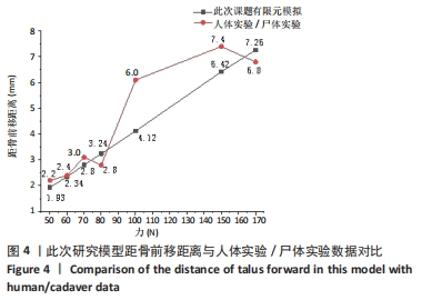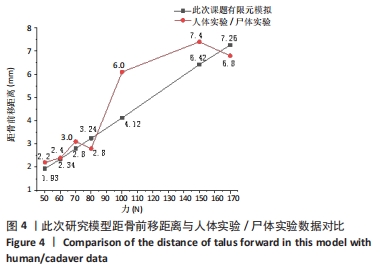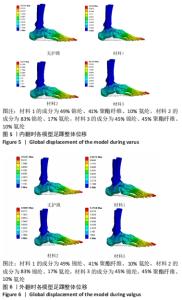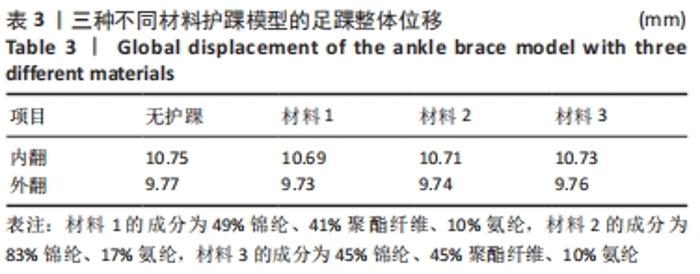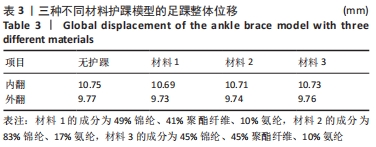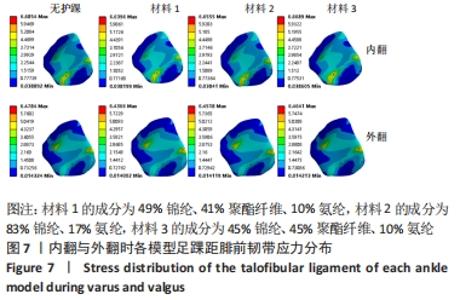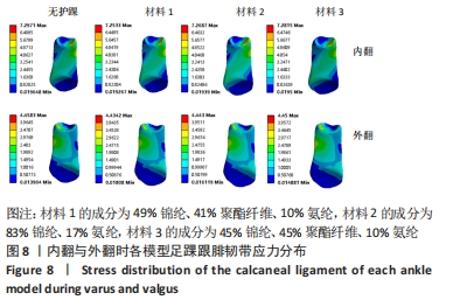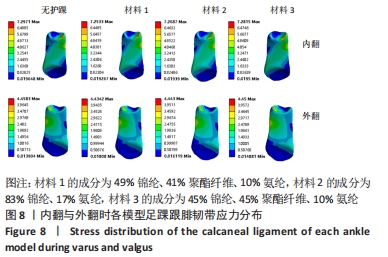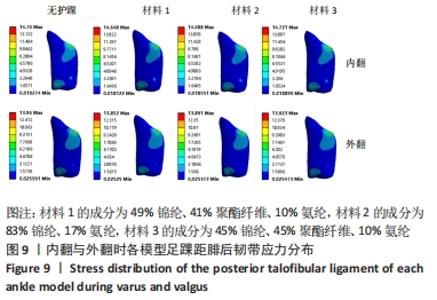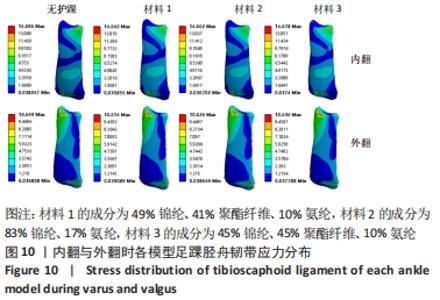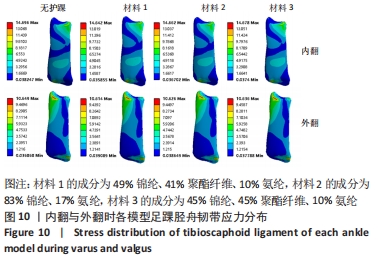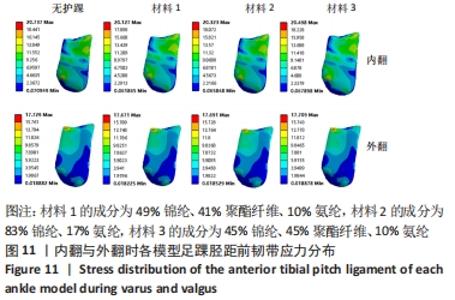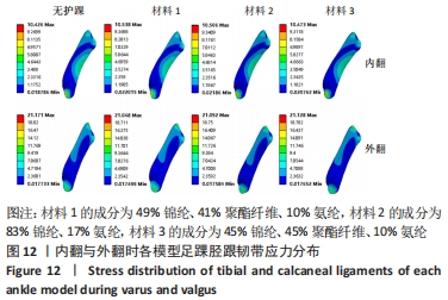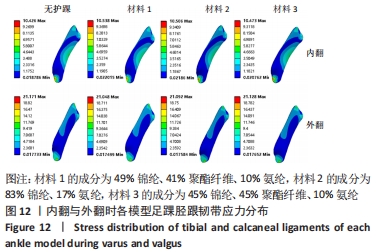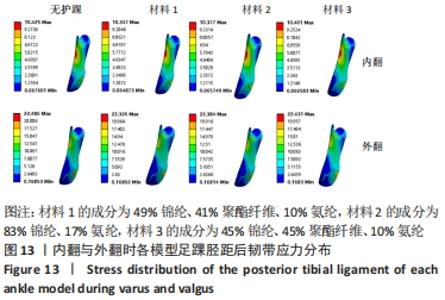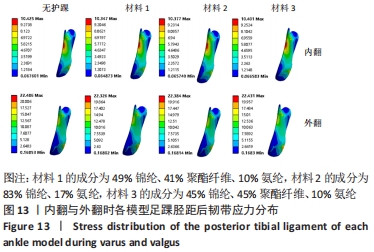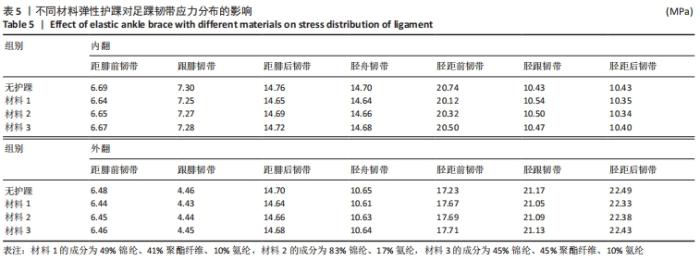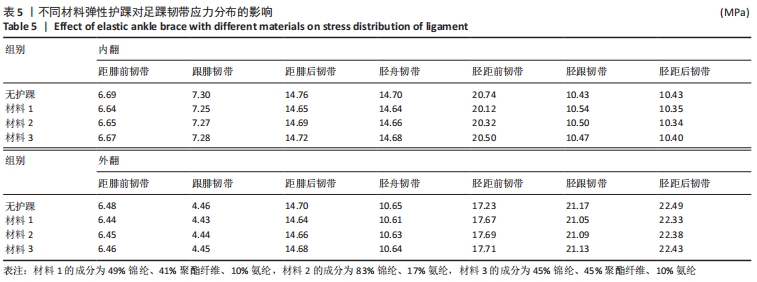Chinese Journal of Tissue Engineering Research ›› 2023, Vol. 27 ›› Issue (7): 1031-1037.doi: 10.12307/2023.071
Previous Articles Next Articles
Finite element analysis of elastic ankle brace performance
Guo Tingting1, Xie Hong1, Xu Guanghua2
- 1School of Textiles and Fashion, Shanghai University of Engineering Science, Shanghai 201600, China; 2Institute of Sports Medicine, North University of China, Taiyuan 030051, Shanxi Province, China
-
Received:2021-10-27Accepted:2022-04-18Online:2023-03-08Published:2022-07-18 -
Contact:Xie Hong, MD, Professor, School of Textiles and Fashion, Shanghai University of Engineering Science, Shanghai 201600, China -
About author:Guo Tingting, Master, School of Textiles and Fashion, Shanghai University of Engineering Science, Shanghai 201600, China -
Supported by:National Key Special Project, No. 2018YFC2000901 (to XH); Graduate Research Innovation Project of Shanghai University of Engineering Science, No. 20KY0915 (to GTT)
CLC Number:
Cite this article
Guo Tingting, Xie Hong, Xu Guanghua. Finite element analysis of elastic ankle brace performance[J]. Chinese Journal of Tissue Engineering Research, 2023, 27(7): 1031-1037.
share this article
Add to citation manager EndNote|Reference Manager|ProCite|BibTeX|RefWorks
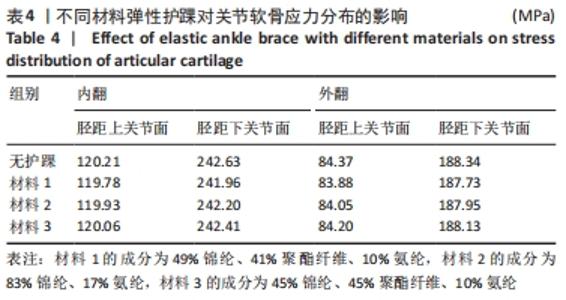
2.3.2 不同材料弹性护踝对足踝关节软骨的应力分布的影响 分析结果表明,在内翻、外翻的足踝运动过程中,有或无护踝状态下的胫距上下关节面峰值应力,见表4所示,应力集中的位置为关节面接触位置,是易发生损伤的位置,穿着不同材料的护踝都使峰值应力有所降低,效果最好的是材料1,使得胫距上关节面峰值应力在内翻、外翻状态下分别降低了约0.48 MPa和0.49 MPa,胫距下关节面的峰值应力分别降低了0.67 MPa和0.61 MPa,材料2和材料3使胫距上关节面峰值应力在内翻时分别降低了0.28 MPa和0.15 MPa,在外翻时分别降低了0.32 MPa和0.17 MPa,胫距下关节面的峰值应力在内翻时分别降低了0.43 MPa和0.22 MPa,在外翻时分别降低了0.39 MPa和0.21 MPa。"
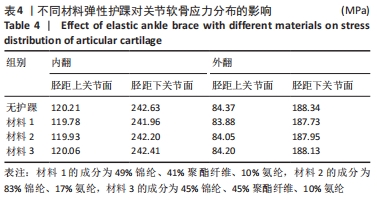
| [1] CREMA MD, BRANISLAV K, ALI G, et al. MRI of ankle sprain: the association between joint effusion and structural injury severity in a large cohort of athletes. Eur Radiol. 2019;29(11):6336-6344. [2] LYTLE JB, PARIKH KB, TARAKEMEH A, et al. Epidemiology of Foot and Ankle Injuries in NCAA Jumping Athletes in the United States During 2009-2014. J Orthop Sports Phys Ther. 2021;9(4):232596712199805. [3] ANDREOLI CV, CHIARAMONTI BC, BURIEL E, et al. Epidemiology of sports injuries in basketball: Integrative systematic review. BMJ Open Sport Exerc Med. 2018;4(1):e000468. [4] HODGKINS CW, WESSLING NA. Epidemiology of Sports-Specific Foot and Ankle Injuries. Foot and Ankle Clin. 2020;26(1):173-185. [5] 隋鹏举.踝部关节运动建模及踝关节康复机构设计[D].福州:福州大学,2011. [6] 徐菲.踝足数值模型的建立及踝关节外侧失稳的距骨有限元分析[D].天津:天津医科大学,2009. [7] VANWANSEELE B, STUELCKEN M, GREENE A, et al. The effect of external ankle support on knee and ankle joint loading in netball players. J Sci Med Sport. 2014;17(5):511-515. [8] FUERST P, GOLLHOFER A, WENNING M, et al. People with chronic ankle instability benefit from brace application in highly dynamic change of direction movements. J Foot Ankle Res. 2021;14(1):13. [9] FREY C, FEDER KS, SLEIGHT J. Prophylactic ankle brace use in high school volleyball players: a prospective study. Foot Ankle Int. 2010; 31(4):296-300. [10] KLEM NR, WILD CY, WILLIAMS SA, et al. Effect of External Ankle Support on Ankle and Knee Biomechanics During the Cutting Maneuver in Basketball Players. Am J Sport Med. 2017;45(3):685-691. [11] MATTHEW DJ, ADRIAN BS, TYE SM, et al. Effects of Preventative Ankle Taping on Planned Change-of-Direction and Reactive Agility Performance and Ankle Muscle Activity in Basketballers. J Sport Sci Med. 2015;14(4):864-876. [12] CORDOVA ML, INGERSOLL CD. Peroneus longus stretch reflex amplitude increases after ankle brace application. Brit J Sport Med. 2003;37(3): 258-262. [13] AKRAMI M, QIAN Z, ZOU Z, et al. Subject-specific finite element modelling of the human foot complex during walking: sensitivity analysis of material properties, boundary and loading conditions. Biomech Model Mechanobiol. 2018;17:559-576. [14] TOHYAMA H, BEYNNON BD, RENSTRÖM PA, et al. Biomechanical analysis of the ankle anterior drawer test for anterior talofibular ligament injuries. J Orthop Res. 1995;13(4):609-614. [15] TOHYAMA H, YASUDA K, OHKOSHI Y, et al. Anterior drawer test for acute anterior talofibular ligament injuries of the ankle. How much load should be applied during the test. Am J Sport Med. 2003;31(2):226-232. [16] BAHR R, PENA F, SHINE J, et al. Mechanics of the anterior drawer and talar tilt tests. A cadaveric study of lateral ligament injuries of the ankle. Acta Orthop Scand. 1997;68(5):435-441. [17] Johnson EE, Markolf KL. The contribution of the anterior talofibular ligament to ankle laxity. J Bone Joint Surg Am. 1983;65(1):81-88. [18] TERAMOTO A, IBA K, MURAHASHI Y, et al. Quantitative Evaluation of Ankle Instability Using a Capacitance-Type Strain Sensor. Foot Ankle Int. 2021;42(8):1074-1080. [19] BEHRENS SB, DRAKOS M, LEE BJ, et al. Biomechanical analysis of Brostrom versus Brostrom-Gould lateral ankle instability repairs. Foot Ankle Int. 2013;34(4):587-592. [20] CHEUNG TM, ZHANG M, AN KN. Effects of plantar fascia stiffness on the biomechanical responses of the ankle–foot complex. Clin Biomech. 2004;19(8):839-846. [21] QIU TX, TEO EC, YAN YB, et al. Finite element modeling of a 3D coupled foot–boot model. Med Eng Phys. 2011;33(10):1228-1233. |
| [1] | Du Xueting, Zhang Xiaodong, Chen Yanjun, Wang Mei, Chen Wubiao, Huang Wenhua. Application of compressed sensing technology in two-dimensional magnetic resonance imaging of the ankle joint [J]. Chinese Journal of Tissue Engineering Research, 2023, 27(9): 1396-1402. |
| [2] | Yu He, Zheng Jiafa, Song Xiufeng, Guan Shengyi. Tibiotalocalcaneal arthrodesis with blood supplied fibular flap combined with hollow screw in the treatment of end-stage ankle osteoarthritis [J]. Chinese Journal of Tissue Engineering Research, 2023, 27(4): 588-593. |
| [3] | Bai Zixing, Cao Xuhan, Sun Chengyi, Yang Yanjun, Chen Si, Wen Jianmin, Lin Xinxiao, Sun Weidong. Construction and biomechanical analysis of ankle joint finite element model in gait cycle [J]. Chinese Journal of Tissue Engineering Research, 2022, 26(9): 1362-1366. |
| [4] | Liu Gang, Ma Chao, Wang Le, Zeng Jie, Jiao Yong, Zhao Yi, Ren Jingpei, Hu Chuanyu, Xu Lin, Mu Xiaohong. Ankle-foot orthoses improve motor function of children with cerebral palsy: a Meta-analysis based on 12 randomized controlled trials [J]. Chinese Journal of Tissue Engineering Research, 2022, 26(8): 1299-1304. |
| [5] | Shao Yangyang, Zhang Junxia, Jiang Meijiao, Liu Zelong, Gao Kun, Yu Shuhan. Kinematics characteristics of lower limb joints of young men running wearing knee pads [J]. Chinese Journal of Tissue Engineering Research, 2022, 26(6): 832-837. |
| [6] | Liu Yuhang, Zhou Jianqiang, Xu Xuebin, Qu Xingyue, Li Ziyu, Li Kun, Wang Xing, Li Zhijun, Li Xiaohe, Zhang Shaojie. Establishment and validation of finite element model of lower cervical spine in 6-year-old children [J]. Chinese Journal of Tissue Engineering Research, 2022, 26(6): 870-874. |
| [7] | Xu Kuishuai, Zhang Liang, Chen Jinli, Ren Zhongkai, Zhao Xia, Li Tianyu, Yu Tengbo. Effect of force line changes on lower limb joints after medial open wedge high tibial osteotomy [J]. Chinese Journal of Tissue Engineering Research, 2022, 26(6): 821-826. |
| [8] | Yin Yikun, Wang Jialin, Wu Chaoming, Sun Junzhi. Joint mobilization treatment for chronic ankle instability function recovery: a meta-analysis [J]. Chinese Journal of Tissue Engineering Research, 2022, 26(33): 5407-5412. |
| [9] | Ding Junwen, Mi Tao, Li Zeqing, Ren Rong, Tang Baoming, Luo Wei, Li Zhaowei. Biomechanical finite element analysis of lower tibiofibular ligament [J]. Chinese Journal of Tissue Engineering Research, 2022, 26(33): 5259-5264. |
| [10] | Jia Caixia, He Si, Ha Xiaoqin. In vitro isolation, culture and identification of chondrocytes from the ankle joint of aged mice [J]. Chinese Journal of Tissue Engineering Research, 2022, 26(32): 5097-5101. |
| [11] | Liu Yubo, Zhang Huizeng, Zhang Tongrun, Sui Gengyi, Ma Nan, Cheng Xu, Gao Xupeng, Xu Jing, Wang Chaoliang. Correlation analysis between the morphological changes of ankle acupoints and the ankle function after ankle fracture surgery [J]. Chinese Journal of Tissue Engineering Research, 2022, 26(3): 440-445. |
| [12] | Li Zhishuai, Zhang Hongqian, Li Li, Han Xinwen, Feng Jing. Finite element analysis of the knee joint: research hotspots and trends [J]. Chinese Journal of Tissue Engineering Research, 2022, 26(15): 2412-2418. |
| [13] | Li Qichen, Han Shufeng, Jia Erlong, Jia Yanan. Ankle joint fracture with deltoid ligament injury: repair and reconstruction [J]. Chinese Journal of Tissue Engineering Research, 2022, 26(11): 1793-1798. |
| [14] | Zhang Jichao, Dong Wanpeng, Dong Yuefu, Zhang Zhen, Li Jiayi, Ren Meng. Parameters of finite element model of the knee joint [J]. Chinese Journal of Tissue Engineering Research, 2021, 25(30): 4781-4786. |
| [15] | Zhang Xinming, Liu Zhihua, Zhang Xinmin, Shen Yankui, Wang Chunli. Establishment of a total cervical spine model and characteristics of traction force and traction angles under different traction orientations [J]. Chinese Journal of Tissue Engineering Research, 2021, 25(30): 4805-4811. |
| Viewed | ||||||
|
Full text |
|
|||||
|
Abstract |
|
|||||
